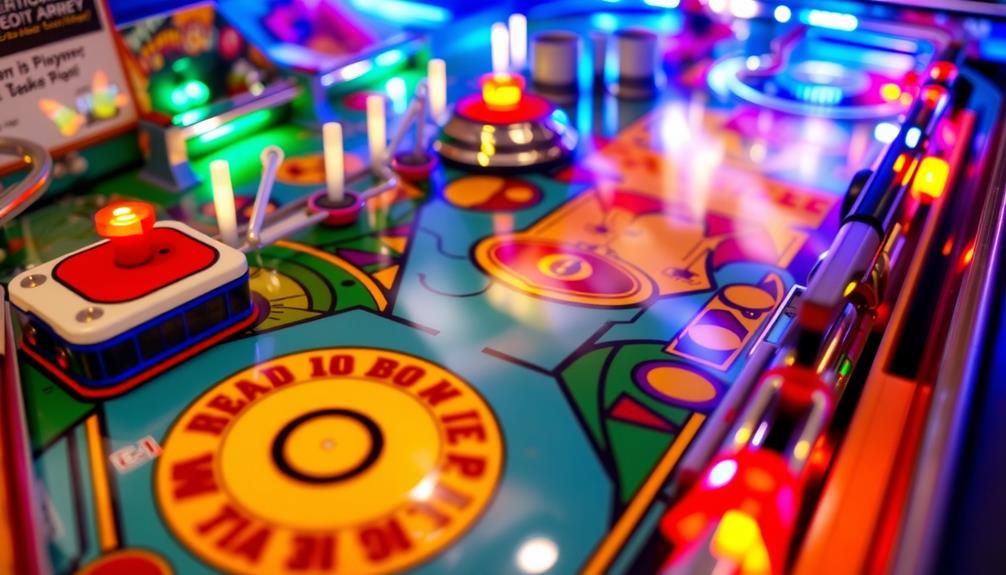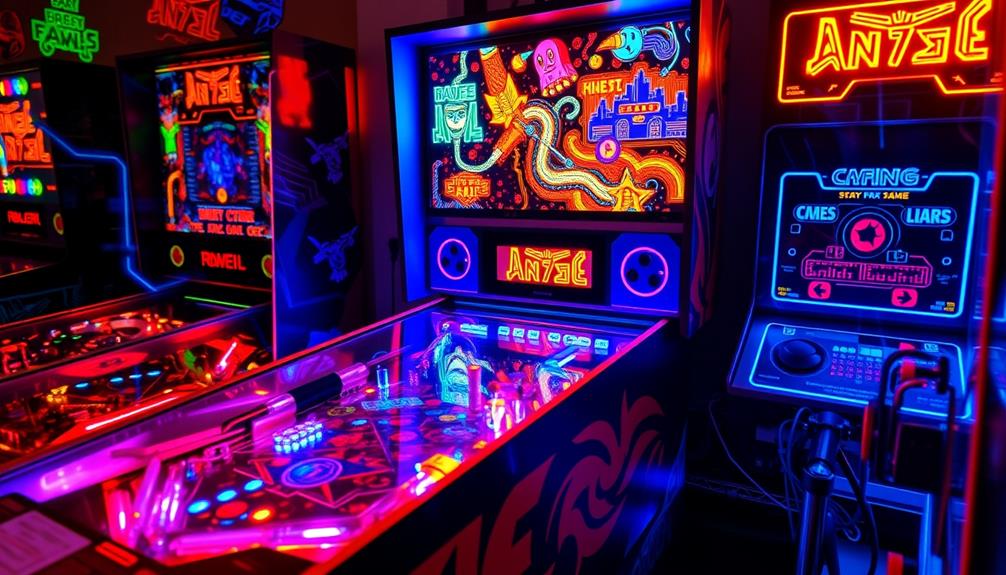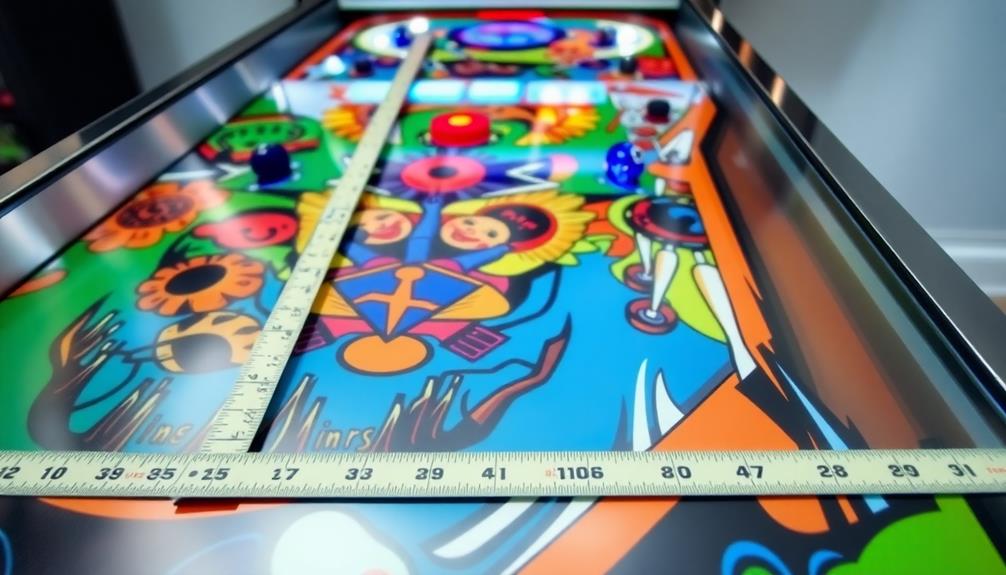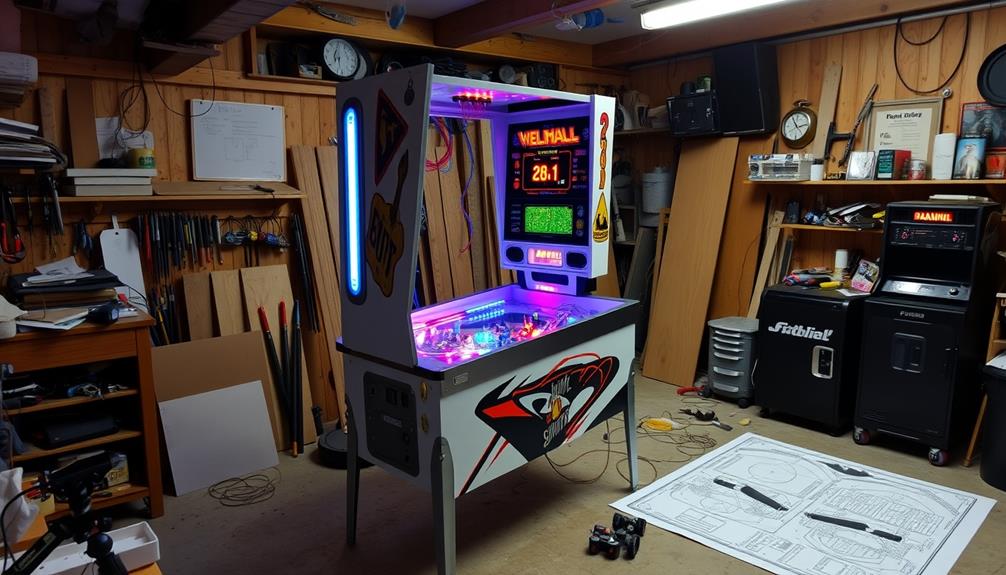Pinball machines are captivating arcade games where you launch a metal ball and aim to hit various targets on a dynamic playfield. You control the ball using flippers, mastering timing and strategy to rack up points. With origins dating back to the 18th century, pinball has evolved considerably over the years, becoming a staple in entertainment venues. Modern machines now feature advanced technology like LCD screens and contactless payments, enhancing the overall experience. Whether you are competing for high scores or simply enjoying the excitement, there is a rich history and culture surrounding pinball that you may find fascinating. The allure of pinball transcends generations, attracting new fans with the sound of the play can can pinball game and the flashing lights that create an immersive atmosphere. Combining nostalgia and innovation, pinball remains a beloved pastime for many.
Key Takeaways
- Pinball machines are arcade games where players score points by launching a metal ball and hitting various targets using flippers.
- They evolved from the 18th-century game Bagatelle and gained popularity with the introduction of electromechanical features in the 1930s.
- Modern pinball machines incorporate technology like LCD screens and animatronics for enhanced gameplay and visual appeal.
- Players use skillful timing and strategy to score points through mechanisms like bumpers, rollover slots, and flippers.
- Competitive tournaments and a resurgence in vintage machine collecting highlight the cultural significance of pinball in gaming history.
History of Pinball Machines
Originating from the 18th-century parlor game Bagatelle, pinball machines have a rich history that dates back centuries. The term "pinball" was officially coined in 1936, marking a significant evolution in the game.
You'll find that the first pinball machine, created in the 1930s, laid the foundation for modern gaming experiences. With games like Ballyhoo and Baffle Ball, players began to engage in a new form of entertainment.
The introduction of electromechanical pinball machines in the early 1930s transformed the landscape, leading to an era where gameplay mechanics became more complex and engaging, much like how astrology influences attractiveness in personal interactions.
By 1947, the addition of flippers revolutionized the gameplay, shifting it from pure luck to a skill-based experience. This change not only enhanced player engagement but also set the stage for what many consider the golden age of pinball, where machines became more intricate and visually appealing.
The popularity of pinball has fluctuated over the decades, with a decline during the late 20th century as video games took center stage.
However, the resurgence in the 2000s, fueled by retro gaming trends and home machine sales, has revitalized interest in the history of pinball, bringing new players to this classic arcade staple.
Gameplay Mechanics

In pinball, scoring mechanisms play an essential role in your gameplay experience.
Understanding the importance of budgeting your time can help enhance your enjoyment as you strategize how to maximize your points.
You control the action with flippers, maneuvering the ball to hit targets while avoiding the tilt penalty.
Understanding these dynamics can greatly improve your strategy and enjoyment of the game.
Scoring Mechanisms Explained
During a game of pinball, scoring mechanisms play an essential role in the overall experience, guiding your strategy and decisions.
You'll score points through various methods, including gates, bumpers, and holes that register hits, accumulating your score on a lighted panel. Each successful hit brings you closer to racking up as many points as possible. The excitement of scoring can sometimes mimic the anticipation found in family photoshoot fails, where unexpected moments create unforgettable memories.
Rollover slots can multiply your scores, rewarding you for hitting specific targets in succession. The thrill of seeing your score climb is often accompanied by bells and lights, providing immediate feedback and enhancing your gameplay experience.
However, be cautious! The tilt mechanism is designed to prevent cheating, activating when you apply excessive force to the machine. If triggered, it results in a score penalty, which can be frustrating when you're trying to secure high scores.
Competing for high scores is a fundamental part of pinball's allure. Many players aim for initials on the leaderboard, fostering a sense of competition that keeps you coming back for more.
Understanding these scoring mechanisms can elevate your game and make every flip of the flipper count!
Player Control Features
Player control features are essential to the pinball experience, allowing you to actively engage with the game. At the heart of this interaction are the flippers at the bottom of the playfield. These controlled levers enable you to redirect the ball, requiring skill and timing to maximize your score.
When you pull the ball shooter, you're not just launching the ball; you're kicking off your adventure in aiming for high points. Additionally, the excitement of gameplay can evoke feelings of joy and nostalgia, similar to the uplifting themes found in songs like Blue Skies and Lemonade.
Throughout your gameplay, you'll encounter various interactive elements that enhance your strategy. For instance, hitting standup and drop targets, as well as maneuvering ramps and loops, creates unexpected ball trajectories that can lead to big scores. Scoring can be further amplified by rollover slots, which multiply your points when the ball passes over them.
Modern machines add even more depth with additional player control options. You might find extra buttons for launching the ball or activating special game features, providing layers of strategy that keep you on your toes.
These player control features transform each game into a unique challenge, making every session an exciting test of skill and reflexes.
Tilt and Game Dynamics
Tilt mechanics play a crucial role in shaping the dynamics of pinball gameplay. Invented by Harry Williams in 1935, the tilt mechanism prevents cheating by detecting excessive force applied to the machine. If you push too hard, you'll receive a warning before penalties kick in, adding an element of strategy to your play.
This nuanced interaction mirrors the iterative prototyping and testing seen in design thinking practices, where each decision impacts the overall outcome.
As you engage with the flippers, your goal is to direct the ball toward various targets, bumpers, and ramps. This interaction not only enhances scoring but also showcases the intricate game mechanics of pinball. Rollover slots can multiply your points, rewarding skillful shots and quick reflexes.
Physical manipulation of the machine, often referred to as "body English," can also influence the ball's trajectory, making every game unique.
Modern pinball machines feature multi-level playfields that introduce unexpected paths and dynamic gameplay experiences. Components like bumpers, spinners, and slingshots drastically alter the ball's movement, adding layers of complexity to your strategy.
Scoring Systems

When you play pinball, you'll quickly notice how the scoring mechanisms work, rewarding you for hitting targets and achieving objectives.
The excitement of the game often parallels the therapeutic benefits of essential oils, such as how essential oils for toothache relief can provide comfort during a challenging time.
Rollover slots can multiply your score, adding excitement and strategy to the game.
Plus, understanding the tilt mechanism is vital, as it can impact your score if you push the limits too far.
Scoring Mechanisms Overview
Scoring in pinball machines is an exciting blend of skill and strategy, designed to keep players engaged and rewarded throughout their gameplay. Each time you hit targets, complete missions, or navigate ramps and loops, you rack up points, contributing to your overall score.
Additionally, understanding the risks and rewards of investments can enhance your strategic gameplay, much like evaluating potential returns in a financial portfolio. Initially, scores might range from tens of thousands to millions, but modern machines often feature advanced systems that can boost your points greatly, especially when you trigger rollover slots.
As you play, you'll notice that scoring events are accompanied by visual and auditory feedback—flashing lights and ringing bells enhance your sense of achievement and excitement.
However, be careful not to trigger the tilt mechanism! This feature activates if you apply excessive force to the machine, preventing you from manipulating it for an unfair advantage.
If you manage to achieve high scores, you can proudly input your initials on the leaderboard, showcasing your success to other players.
Rollover Slots Functionality
Rollover slots play a vital role in enhancing your scoring strategy in pinball machines. These specific areas on the playfield activate when the ball rolls over them, adding a set number of points to your score or triggering additional game features. Each rollover slot can have different scoring values, which often increase as you hit consecutive slots or complete specific objectives.
Understanding the mechanics of scoring can really elevate your gameplay and provide a more thrilling experience, similar to how different brewing methods impact caffeine content in coffee various brewing methods.
You'll notice that rollover slots are typically designed with distinct colors or markings, making them visually appealing and easy to identify. This design not only adds to the overall aesthetic of the playfield but also helps players strategize their gameplay.
The scoring from rollover slots can be multiplied through various game mechanics, like hitting a certain target or achieving a specific score threshold.
As a player, aiming for these rollover slots is essential for maximizing your score and climbing up the leaderboard. By understanding the functionality of rollover slots, you can refine your approach and improve your overall performance in the game.
Keep an eye on these scoring opportunities, and you'll find that they can greatly impact your success in pinball.
Tilt Mechanism Impact
The tilt mechanism plays an essential role in the integrity of pinball scoring systems. Invented by Harry Williams in 1935, it's designed to prevent cheating by detecting excessive movement. When you, as a player, push or shake the machine too hard, the tilt mechanism activates, usually resulting in a warning. If you don't correct your behavior, it can void your current score or even end your turn, impacting your overall game performance. This concept resonates with the philosophical exploration of balance and ethics in decision-making, as it encourages players to reflect on their actions while engaging in a competitive environment (insights on ethical decision-making).
Early tilt mechanisms featured two sensing devices: one for side-to-side movements and another for slam tilts, which added fairness to the gameplay. This innovation allows for a nuanced interaction between skill and chance. You might try using "body English" to influence the ball's path, but be cautious—overdoing it can easily trigger the tilt mechanism.
In pinball machines, scoring systems rely on electrical contacts that accumulate points based on your actions. Therefore, any penalties from the tilt mechanism can drastically alter your score and game dynamics.
Balancing skillful play with the machine's limitations is key to mastering the game while staying within the rules.
Key Components of Pinball

Pinball machines are intricate devices that rely on several key components to create an engaging gameplay experience. Understanding these elements can enhance your appreciation of the game. Here are three essential components: The first essential component of pinball machines is the playfield, which serves as the main surface for the ball to interact with. The playfield is usually adorned with various obstacles and features to challenge players and keep the game interesting. Another crucial aspect is the pinball flipper mechanisms, which are controlled by the player to launch and strike the ball. These flippers require precision timing and skillful manipulation to effectively control the ball’s movement and aim for specific targets on the playfield. Understanding the mechanics of these flipper mechanisms can greatly improve a player’s ability to achieve high scores and master the game.
- Cabinet: This main frame, usually made from wood, houses the playfield and all internal mechanisms, providing structural support. The design and construction of the cabinet can also affect the acoustics of the game, enhancing the overall sound experience similar to how acoustics and soundproofing improve audio in home cinema setups.
- Playfield: The inclined area where gameplay unfolds, filled with targets, ramps, and bumpers that interact with the ball, creating dynamic challenges. The arrangement and features of the playfield are important for keeping players engaged and entertained.
- Flippers: Located at the bottom of the playfield, these player-controlled levers allow you to hit the ball, directing its movement and greatly affecting your strategy.
Additionally, the plunger plays a significant role in launching the ball into the playfield at the start of each game, giving you the chance to aim for high scores.
Finally, a backbox sits atop the cabinet, showcasing scoring displays and artwork, often illuminated to enhance visual appeal.
Each of these components works together to create the unique and exciting experience that pinball offers, inviting players to refine their skills and strategies with every game.
Technological Advancements

Over the years, pinball machines have evolved considerably, thanks to various technological advancements. The first electrically powered pinball machine made its debut in 1933, introducing sound effects with electromechanical bells and buzzers.
Fast forward to 1975, when Bally launched the Micro's Spirit of 76, marking the era of the solid-state electronic pinball machine. This innovation paved the way for modern gameplay, allowing for more complex scoring and features.
Today's modern pinball machines are a far cry from their predecessors, incorporating advanced technology like animatronics and vibrant LCD screens. These enhancements not only elevate the visual experience but also make gameplay more interactive and engaging.
The shift from mechanical reels to digital screens in the late 2010s enabled dynamic animations and enthralling video content to accompany each game.
Additionally, payment methods have seen significant improvements; early 2020s machines now feature contactless payment terminals, making it easier for you to enjoy your favorite pinball games without fumbling for coins.
These technological advancements continue to shape the pinball landscape, ensuring that every player experiences the excitement of this classic game in new and innovative ways.
Cultural Impact

Throughout the years, pinball machines have carved out a unique niche in gaming culture, influencing everything from competitive tournaments to pop culture references. Here are three key aspects of their cultural impact:
- Competitive Tournaments: Organized by the International Flipper Pinball Association (IFPA), these events attract enthusiasts worldwide, showcasing the skill and excitement of pinball play.
- Pop Culture Presence: You can't ignore the nostalgic charm of pinball machines in movies and TV shows, highlighting their artistic value and how they resonate with audiences.
- Vintage Appeal: The resurgence of retro gaming since the 2000s has sparked interest in home ownership of vintage pinball machines, further emphasizing their enduring allure.
Communities have blossomed around collecting and restoring these vintage pinball machines, enhancing the social aspect of this hobby.
Collectors appreciate the craftsmanship involved in maintaining these devices, recognizing modern machines as a mix of entertainment and visual art.
With intricate designs and engaging themes, pinball machines not only entertain but also serve as a demonstration of the evolving nature of gaming culture.
You can truly see how deeply embedded they're in the fabric of our shared experiences.
Challenges Facing Pinball

The vibrant culture surrounding pinball machines faces significant challenges in today's entertainment landscape. The rise of video games has led to a notable decline in pinball sales, with major manufacturers like Williams selling fewer than 4,000 units by the late 1990s. This shift highlights the need for innovation within the industry.
| Challenge | Impact on Pinball |
|---|---|
| Decline in sales | Fewer manufacturers active |
| Competition from video games | Reduced consumer interest |
| Economic downturns | Closure of major companies |
| Lack of innovation | Stagnation of machine design |
| Limited new players | Diminished pinball culture |
The closure of iconic companies like Gottlieb and Capcom in 1996 illustrates the industry's struggle to adapt to changing consumer preferences. Although Stern Pinball has emerged as a dominant player post-1990s, the overall market still grapples with maintaining consistent sales. As a pinball enthusiast, you can see that while there's potential for revival, manufacturers must focus on innovative strategies to capture attention in a world increasingly captivated by digital entertainment.
Future of Pinball Machines

Pinball machines are on the brink of a revival, thanks to exciting advancements in technology and design. Here's what you can expect in the future:
- Enhanced Gameplay: With advanced technologies like LED lighting and LCD displays, you'll enjoy immersive themes that attract a broader audience.
- Home Ownership: The market for home consoles has surged, making it a great time to invest in physical machines that are gaining popularity among collectors and enthusiasts.
- Innovative Designs: Independent manufacturers, such as Spooky Pinball and Jersey Jack Pinball, are introducing unique designs and collaborations with popular franchises, breathing new life into the pinball landscape.
Additionally, the rise of virtual pinball machines (vpins) brings a digital twist, allowing players like you to enjoy pinball in a new way.
Future games may also feature online modes for score tracking, connecting you with players around the globe and adding a competitive edge.
As these trends continue to develop, pinball will likely blend physical and virtual experiences, creating a dynamic future for this beloved pastime.
Get ready to embrace the new era of pinball!
Frequently Asked Questions
What Is the Purpose of a Pinball Machine?
The purpose of a pinball machine is to challenge you, offering an interactive experience where you score points by skillfully launching a ball, hitting targets, and mastering gameplay mechanics while competing for high scores.
What Is Pinball and Why Was It Illegal?
Imagine playing a game where your skill's ignored, and luck decides your fate. That's why pinball was illegal; authorities saw it as gambling. It took a landmark ruling for you to enjoy it legally.
What Is the Concept of Pinball?
Pinball's concept revolves around skillfully launching a ball, maneuvering through targets and bumpers, and scoring points. You aim, flip, and react in real-time, creating an engaging experience filled with excitement and competition. Enjoy the challenge!
What Happens in a Pinball Machine?
As you launch the silver ball, it dances across the vibrant playfield, colliding with bumpers and targets. You skillfully flick the flippers, chasing high scores, while lights flash and sounds cheer your every move.
Conclusion
To sum up, pinball machines have evolved from simple wooden games to sophisticated, technology-driven entertainment. Did you know that in 2020, there were over 25,000 pinball machines sold worldwide? This statistic highlights the enduring popularity of pinball, despite the challenges it faces in a digital age. As the industry continues to innovate and embrace new technologies, it's clear that pinball will remain a beloved pastime for generations to come.









